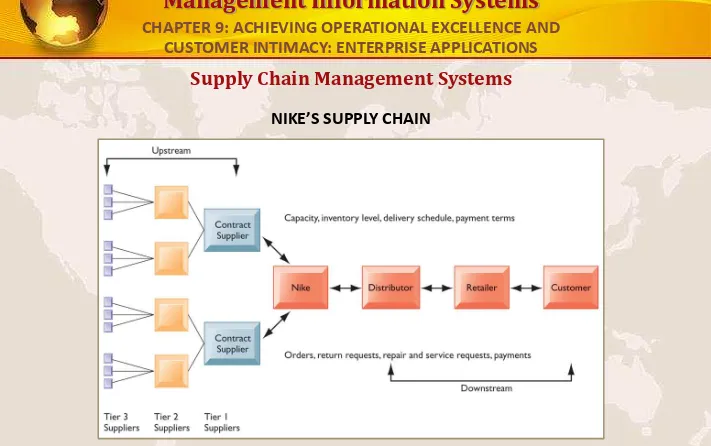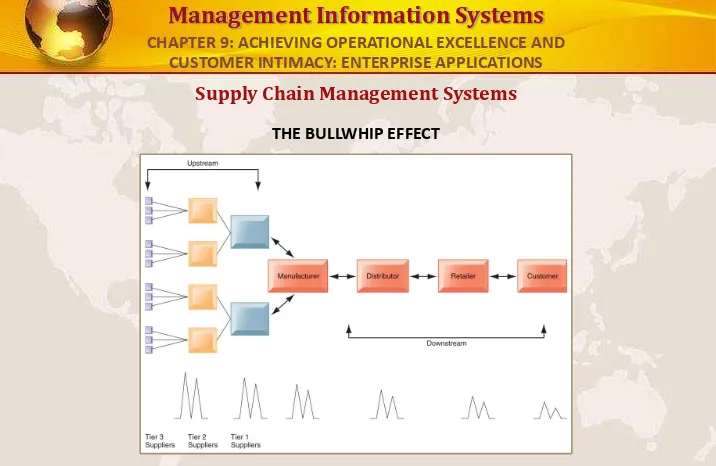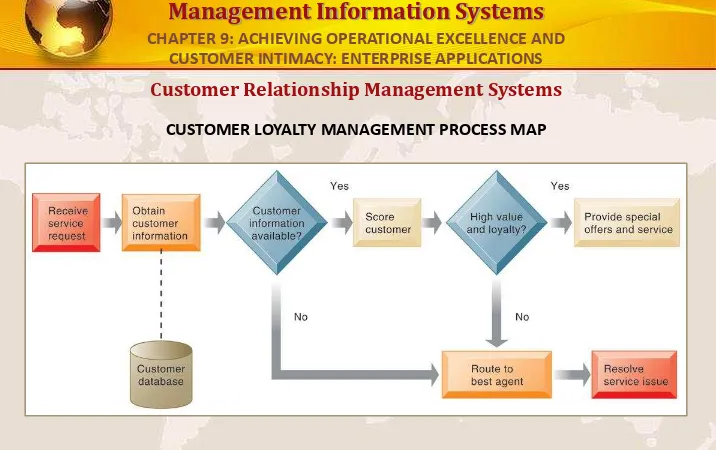Management Information Systems
MANAGING THE DIGITAL FIRM, 12THEDITION
MENCAPAI KEUNGGULAN
OPERASIONAL DAN KEINTIMAN
PELANGGAN: ENTERPRISE
APPLICATIONS
Chapter 9
VIDEO CASES
Case 1: Sinosteel Strengthens Business Management with ERP Applications Case 2: Ingram Micro and H&R Block Get Close to Their Customers
Management Information Systems
•
Bagaimana sistem perusahaan membantu bisnis mencapai
keunggulan operasional?
•
Bagaimana sistem manajemen rantai pasokan
mengkoordinasikan perencanaan, produksi, dan logistik
dengan pemasok?
•
Bagaimana sistem manajemen hubungan pelanggan
membantu perusahaan mencapai customer kedekatan?
•
Apa saja tantangan yang ditimbulkan oleh aplikasi
enterprise?
•
Bagaimana aplikasi perusahaan yang digunakan dalam
platform untuk layanan lintas-fungsional baru?
Learning Objectives
Management Information Systems
•
Problem
–
Mengelola bagian dalam terus berubah lini
produk dengan pemasok di banyak negara
•
Solution
–
Ganti peninggalan (
Materials Requirement
Planning
) MRPs dengan Kinaxis on-demand layanan
software Tanggapan Cepat
–
Memungkinkan kedua Cannondale dan pemasok untuk melihat
informasi up-to-date, respon pelanggan lebih cepat, persediaan
berkurang, mengurangi siklus dan menjalankannya
•
Illustrates:
Perlu untuk sistem seluruh perusahaan untuk
mengkoordinasikan rantai pasokan
•
Demonstrates:
Penggunaan layanan cloud sebagai solusi
untuk menerapkan aplikasi enterprise
Cannondale Belajar Mengelola Rantai Pasokan Global
CHAPTER 9: ACHIEVING OPERATIONAL EXCELLENCE AND CUSTOMER INTIMACY: ENTERPRISE APPLICATIONS
Management Information Systems
•
Enterprise Systems
–
Juga disebut "enterprise resource planning (ERP)
sistem"
–
Suite modul perangkat lunak yang terintegrasi
dan database pusat umum
–
Data
Mengumpulkan
dari
berbagai
divisi
perusahaan untuk digunakan dalam hampir
semua kegiatan bisnis internal perusahaan
–
Informasi yang dimasukkan dalam satu proses
segera tersedia untuk proses lainnya
Enterprise Systems
Management Information Systems
CHAPTER 9: ACHIEVING OPERATIONAL EXCELLENCE AND CUSTOMER INTIMACY: ENTERPRISE APPLICATIONS
•
Enterprise Software
–
Dibangun sekitar ribuan proses bisnis yang telah ditetapkan yang
mencerminkan praktik terbaik
•
Finance/accounting: General ledger, accounts payable, etc.
•
Human resources: Personnel administration, payroll, etc.
•
Manufacturing/production: Purchasing, shipping, etc.
•
Sales/marketing: Order processing, billing, sales planning, etc.
–
Untuk mengimplementasikan, perusahaan::
•
Pilih fungsi sistem yang ingin mereka gunakan
•
Peta proses bisnis untuk proses software
– Gunakan tabel konfigurasi perangkat lunak untuk menyesuaikan
Enterprise Systems
Management Information Systems
Enterprise Systems
CARA KERJA SISTEM ENTERPRISE
Sistem perusahaan memiliki satu set modul perangkat lunak yang terintegrasi dan database pusat yang memungkinkan data yang akan dibagi oleh banyak proses bisnis yang berbeda dan bidang fungsional seluruh perusahaan
FIGURE 9-1
Management Information Systems
•
Nilai bisnis dari sistem perusahaan
–
Meningkatkan efisiensi operasional
–
Memberikan informasi yang luas perusahaan untuk
mendukung pengambilan keputusan
–
Memungkinkan respon cepat terhadap permintaan
pelanggan untuk informasi atau produk
–
Sertakan alat analisis untuk mengevaluasi kinerja
organisasi secara keseluruhan
Enterprise Systems
CHAPTER 9: ACHIEVING OPERATIONAL EXCELLENCE AND CUSTOMER INTIMACY: ENTERPRISE APPLICATIONS
Management Information Systems
•
Supply chain:
–
Jaringan organisasi dan proses untuk:
•
Pengadaan bahan baku
•
Mengubahnya menjadi produk
•
Mendistribusikan produk
•
Upstream supply chain:
–
Pemasok perusahaan, para pemasok, proses untuk
mengelola hubungan dengan mereka
•
Downstream supply chain:
–
Organisasi dan proses yang bertanggung jawab untuk
memberikan produk kepada pelanggan
Supply Chain Management Systems
Management Information Systems
Supply Chain Management Systems
NIKE’S SUPPLY CHAIN
Angka ini menggambarkan entitas utama dalam rantai pasokan Nike dan arus informasi hulu dan hilir untuk mengkoordinasikan kegiatan yang terlibat dalam membeli, membuat, dan bergerak produk. Ditampilkan di sini adalah rantai pasokan disederhanakan, dengan bagian hulu hanya berfokus pada pemasok untuk sepatu dan sol sepatu.
FIGURE 9-2
CHAPTER 9: ACHIEVING OPERATIONAL EXCELLENCE AND CUSTOMER INTIMACY: ENTERPRISE APPLICATIONS
Management Information Systems
•
Information and supply chain management
–
Ketidakefisienan potong biaya operasional perusahaan
•
Bisa membuang hingga 25% dari biaya operasional
–
Just-in-time strategy:
•
Komponen tiba sebagai mereka dibutuhkan
•
Barang jadi dikirim setelah meninggalkan jalur perakitan
–
Safety stock
•
Penyangga karena kurangnya fleksibilitas dalam supply chain
–
Bullwhip effect
•
Informasi tentang permintaan produk terdistorsi saat lewat dari
satu entitas ke depan di seluruh rantai pasokan
Supply Chain Management Systems
Management Information Systems
Supply Chain Management Systems
THE BULLWHIP EFFECT
Informasi yang tidak akurat dapat menyebabkan fluktuasi kecil dalam permintaan untuk produk yang akan diperkuat sebagai salah satu bergerak lebih jauh ke belakang dalam rantai pasokan. Fluktuasi kecil dalam penjualan eceran untuk produk dapat menciptakan kelebihan persediaan untuk distributor, produsen, dan pemasok.
FIGURE 9-3
CHAPTER 9: ACHIEVING OPERATIONAL EXCELLENCE AND CUSTOMER INTIMACY: ENTERPRISE APPLICATIONS
Management Information Systems
•
Supply chain management software
–
Supply chain planning systems
•
Model existing supply chain
•
Demand planning
•
Optimize sourcing, manufacturing plans
•
Establish inventory levels
•
Identifying transportation modes
–
Supply chain execution systems
•
Manage flow of products through distribution centers
and warehouses
Supply Chain Management Systems
Management Information Systems
Read the Interactive Session and discuss the following questions
•
Why is parts inventory management so important at Southwest
Airli es? What usi ess pro esses are affe ted y the airli es’
ability or inability to have required parts on hand?
•
Why management, organization, and technology factors were
respo si le for South est’s pro le s ith i e tory
management?
•
How did implementing the i2 software change the way Southwest
ran its business?
•
Describe two decisions that were improved by implementing the
i2 system?
Supply Chain Management Systems
SOUTHWEST AIRLINES TAKES OFF WITH BETTER SUPPLY CHAIN MANAGEMENT
CHAPTER 9: ACHIEVING OPERATIONAL EXCELLENCE AND CUSTOMER INTIMACY: ENTERPRISE APPLICATIONS
Management Information Systems
•
Global supply chain issues
–
Global supply chains typically span greater
geographic distances and time differences
–
More complex pricing issues (local taxes,
transportation, etc.)
–
Foreign government regulations
•
Internet helps companies manage many aspects of
global supply chains
–
Sourcing, transportation, communications,
international finance
Supply Chain Management Systems
Management Information Systems
•
Supply chain management systems
–
Push-based model (build-to-stock)
•
Schedules based on best guesses of demand
–
Pull-based model (demand-driven)
•
Customer orders trigger events in supply chain
–
Sequential supply chains
•
Information and materials flow sequentially from
company to company
–
Concurrent supply chains
•
Information flows in many directions simultaneously
among members of a supply chain network
Supply Chain Management Systems
CHAPTER 9: ACHIEVING OPERATIONAL EXCELLENCE AND CUSTOMER INTIMACY: ENTERPRISE APPLICATIONS
Management Information Systems
Supply Chain Management Systems
THE BULLWHIP EFFECT
The difference between push- and pull- ased odels is su arized y the sloga , Make what we sell, ot
sell what we ake.
FIGURE 9-4
Management Information Systems
•
Business value of SCM systems
–
Match supply to demand
–
Reduce inventory levels
–
Improve delivery service
–
Speed product time to market
–
Use assets more effectively
–
Reduced supply chain costs lead to increased
profitability
–
Increased sales
Supply Chain Management Systems
CHAPTER 9: ACHIEVING OPERATIONAL EXCELLENCE AND CUSTOMER INTIMACY: ENTERPRISE APPLICATIONS
Management Information Systems
Supply Chain Management Systems
THE FUTURE
INTERNET-DRIVEN SUPPLY CHAIN
The future Internet-driven supply chain operates like a digital logistics nervous system. It provides multidirectional communication among firms, networks of firms, and e-marketplaces so that entire networks of supply chain partners can immediately adjust inventories, orders, and capacities.
FIGURE 9-5
Management Information Systems
•
Knowing the customer
–
In large businesses, too many customers and too
many ways customers interact with firm
•
Customer relationship management (CRM) systems
–
Capture and integrate customer data from all over
the organization
–
Consolidate and analyze customer data
–
Distribute customer information to various systems
and customer touch points across enterprise
–
Provide single enterprise view of customers
Customer Relationship Management Systems
CHAPTER 9: ACHIEVING OPERATIONAL EXCELLENCE AND CUSTOMER INTIMACY: ENTERPRISE APPLICATIONS
Management Information Systems
Customer Relationship Management Systems
CUSTOMER RELATIONSHIP
MANAGEMENT (CRM)
CRM systems examine
customers from a multifaceted perspective. These systems use a set of integrated applications to address all aspects of the customer relationship, including customer service, sales, and marketing.
FIGURE 9-6
Management Information Systems
•
CRM software
–
CRM packages range from niche tools to large-scale
enterprise applications
–
More comprehensive have modules for:
•
Partner relationship management (PRM)
–
Integrating lead generation, pricing, promotions, order
configurations, and availability
–
Tools to assess part ers’ perfor a es
•
Employee relationship management (ERM)
–
E.g. Setting objectives, employee performance management,
performance-based compensation, employee training
Customer Relationship Management Systems
CHAPTER 9: ACHIEVING OPERATIONAL EXCELLENCE AND CUSTOMER INTIMACY: ENTERPRISE APPLICATIONS
Management Information Systems
•
CRM packages typically include tools for:
–
Sales force automation (SFA)
•
E.g. sales prospect and contact information, and sales
quote generation capabilities
–
Customer service
•
E.g. assigning and managing customer service requests;
Web-based self-service capabilities
–
Marketing
•
E.g. capturing prospect and customer data, scheduling
and tracking direct-marketing mailings or e-mail
Customer Relationship Management Systems
Management Information Systems
Customer Relationship Management Systems
HOW CRM
SYSTEMS SUPPORT MARKETING
Customer relationship management software provides a single point for users to manage and evaluate marketing campaigns across multiple channels, including e-mail, direct mail, telephone, the Web, and wireless
messages.
FIGURE 9-7
CHAPTER 9: ACHIEVING OPERATIONAL EXCELLENCE AND CUSTOMER INTIMACY: ENTERPRISE APPLICATIONS
Management Information Systems
Customer Relationship Management Systems
CRM SOFTWARE CAPABILITIES
The major CRM software products support business processes in sales, service, and marketing, integrating customer information from many different sources. Included are support for both the operational and
analytical aspects of CRM.
FIGURE 9-8
Management Information Systems
Customer Relationship Management Systems
CUSTOMER LOYALTY MANAGEMENT PROCESS MAP
This process map shows how a best practice for promoting customer loyalty through customer service would be modeled by customer relationship management software. The CRM software helps firms identify high-value customers for preferential treatment.
FIGURE 9-9
CHAPTER 9: ACHIEVING OPERATIONAL EXCELLENCE AND CUSTOMER INTIMACY: ENTERPRISE APPLICATIONS
Management Information Systems
•
Operational CRM:
–
Customer-facing applications
•
E.g. sales force automation, call center and customer
service support, and marketing automation
•
Analytical CRM:
–
Analyze customer data output from operational CRM
applications
–
Based on data warehouses populated by operational
CRM systems and customer touch points
•
Customer lifetime value (CLTV)
Customer Relationship Management Systems
Management Information Systems
Customer Relationship Management Systems
ANALYTICAL CRM DATA WAREHOUSE
Analytical CRM uses a customer data warehouse and tools to analyze customer data collected from the
fir ’s usto er tou h poi ts a d fro other sour es.
FIGURE 9-10
CHAPTER 9: ACHIEVING OPERATIONAL EXCELLENCE AND CUSTOMER INTIMACY: ENTERPRISE APPLICATIONS
Management Information Systems
•
Business value of CRM
–
Increased customer satisfaction
–
Reduced direct-marketing costs
–
More effective marketing
–
Lower costs for customer acquisition/retention
–
Increased sales revenue
–
Reduce
churn rate
•
Number of customers who stop using or purchasing
products or services from a company.
•
I di ator of growth or de li e of fir ’s usto er ase
Customer Relationship Management Systems
Management Information Systems
•
Highly expensive to purchase and implement
–
$3.5 million to over $12 million
•
Technological changes
•
Business process changes
•
Organizational changes
•
Switching costs, dependence on software vendors
•
Data standardization, management, cleansing
Enterprise Applications: New Opportunities and Challenges
CHAPTER 9: ACHIEVING OPERATIONAL EXCELLENCE AND CUSTOMER INTIMACY: ENTERPRISE APPLICATIONS
Management Information Systems
•
Next-generation enterprise applications
–
Move is to make applications more flexible,
Web-enabled, integrated with other systems
–
Enterprise suites
•
Software to enable CRM, SCM, and enterprise systems
work together and with suppliers and client systems
•
Utilize Web services, SOA
–
Open source & on-demand solutions
–
Mobile compatible; Web 2.0 capabilities
–
Complementary analytics products
Enterprise Applications: New Opportunities and Challenges
Management Information Systems
Read the Interactive Session and discuss the following questions
•
What types of companies are most likely to adopt
cloud-based ERP and CRM software services? Why? What
companies might not be well-suited for this type of
software?
•
What are the advantages and disadvantages of using
cloud-based enterprise applications?
•
What management, organization, and technology issues
should be addressed in deciding whether to use a
conventional ERP or CRM system versus a cloud-based
version?
Enterprise Applications: New Opportunities and Challenges
ENTERPRISE APPLICATIONS MOVE TO THE CLOUD
CHAPTER 9: ACHIEVING OPERATIONAL EXCELLENCE ANDCUSTOMER INTIMACY: ENTERPRISE APPLICATIONS
Management Information Systems
•
Service platform:
–
Integrates multiple applications to deliver
a seamless experience for all parties
•
E.g. Order-to-cash process
–
Portal software
•
Used to integrate information from
enterprise applications and legacy
systems and present it as if coming from
a single source
Enterprise Applications: New Opportunities and Challenges
Management Information Systems
Enterprise Applications: New Opportunities and Challenges
ORDER-TO-CASH SERVICE
Order-to-cash is a composite process that integrates data from individual enterprise systems and legacy financial applications. The process must be modeled and translated into a software system using
[image:33.720.128.709.15.519.2]application integration tools.
FIGURE 9-11
CHAPTER 9: ACHIEVING OPERATIONAL EXCELLENCE AND CUSTOMER INTIMACY: ENTERPRISE APPLICATIONS
Management Information Systems
All rights reserved. No part of this publication may be reproduced, stored in a retrieval system, or transmitted, in any form or by any means, electronic, mechanical, photocopying, recording, or otherwise, without the
prior written permission of the publisher.
Printed in the United States of America.
Copyright © 2011 Pearson Education, Inc.
Publishing as Prentice Hall









